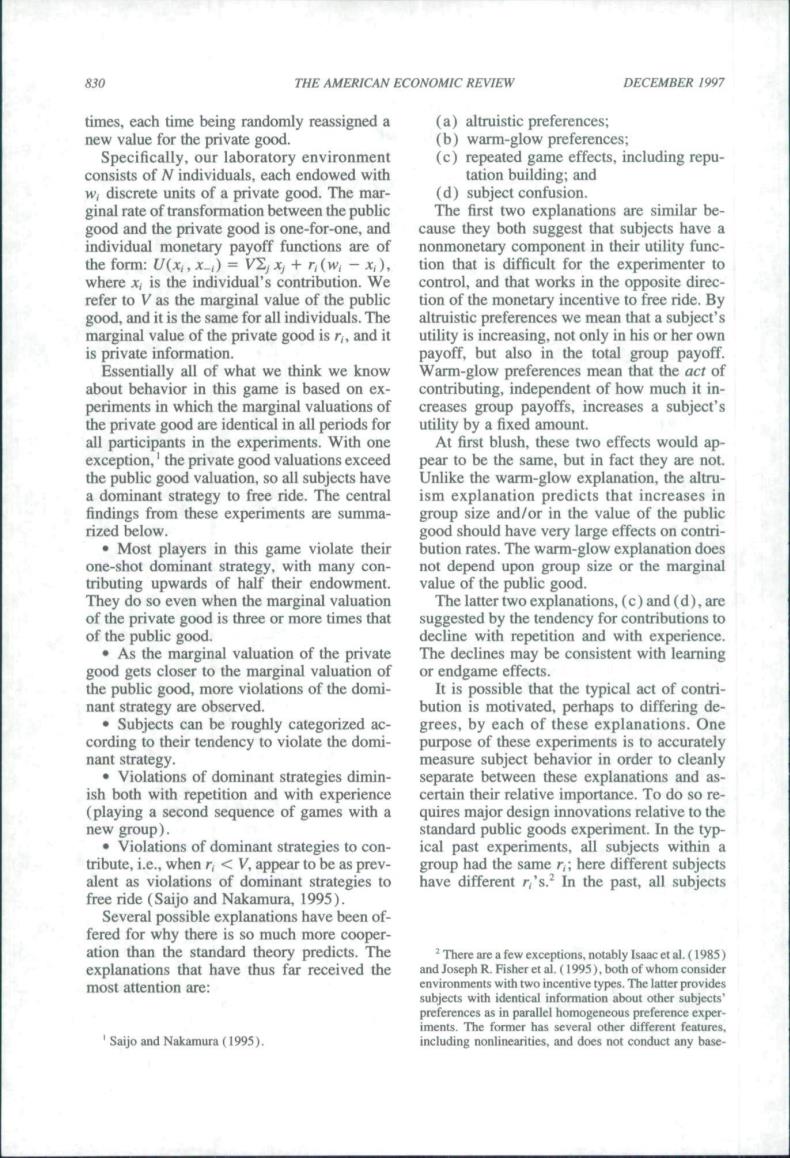正在加载图片...

830 THE AMERICAN ECONOMIC REVIEW DECEMBER 1997 nitegoyegda (a)altruistic prefe our laboratory environment consists of Nindividuals,each endowed with (c)re me effects,including repu tation building:and wdiscrete units of a private good.The mar (d)subject confusion two explanati ns are nonmo onent in their utility fun tion that is difficult for the experimenter to control,and that works in the opposite direc he margin not only in hisorh is private information avof Essentially all of what we think we know his game is b d on ex contributing,indepe dent of how much it in iods f At first blush.these two effects would ap exception,the private good valuations exceed the public good valuation ,s0 jects hav explan tion,the altr good should have very large effects on contri Most players in this game violate their bution rates.The warm-glow explanation doe with many cor of the private good is three or more times that valuatio of the privat nant strategy are observed. bution is motivated, Subje grees,by each of these explanations.On .Violations of dominant strategies dimin- arate between these explanations and as ish both with repetition and with experienc certain their relative importance.To do so re (playing a second sequence of games with a quires major esign innovations r to th e Violations of dominant strateg nes to con ical past exp tribute,i.e..when r<V,appear to be as prev oup had the samer:here different subjects dominant strategies to have different r's.? In the past.all subjects of- fered for why there is so much more coo ation than the standard theory predicts.The The etal.(1985 on ar nce Saijo and Nakamura(1995)830 THE AMERICAN ECONOMIC REVIEW DECEMBER 1997 times, eacb time being randomly reassigned a new value for tbe private good. Specifically, our laboratory environment consists of N individuals, eacb endowed with vv, discrete units of a private good. Tbe marginal rate of transformation between the public good and tbe private good is one-for-one, and individual monetary payoff functions are of the form: UiXi, x-,) = VZj Xj + r,(Wi - jc,), where jc, is the individual's contribution. We refer to V as tbe marginal value of tbe public good, and it is tbe same for all individuals. The marginal value of tbe private good is r,. and it is private information. Essentially all of what we think we know about behavior in tbis game is based on experiments in which the marginal valuations of the private good are identical in all periods for all participants in tbe experiments. Witb one exception,' tbe private good valuations exceed the public good valuation, so all subjects bave a dominant strategy to free ride. The central findings from these experiments are summarized below. • Most players in this game violate tbeir one-sbot dominant strategy, witb many contributing upwards of balf tbeir endowment. They do so even wben the marginal valuation of the private good is three or more times that of the public good. • As the marginal valuation of the private good gets closer to the marginal valuation of tbe public good, more violations of tbe dominant strategy are observed. • Subjects can be roughly categorized according to their tendency to violate tbe dominant strategy. • Violations of dominant strategies diminish botb with repetition and witb experience (playing a second sequence of games with a new group). • Violations of dominant strategies to contribute, i.e., wben r, < V, appear to be as prevalent as violations of dominant strategies to free ride (Saijo and Nakamura. 1995). Several possible explanations bave been offered for wby tbere is so much more cooperation than the standard theory predicts. The explanations that bave thus far received the most attention are: ' Saijo and Nakamura (1995). (a) altruistic preferences; (b) warm-glow preferences; (c) repeated game effects, including reputation building; and (d) subject confusion. Tbe first two explanations are similar because they both suggest tbat subjects have a nonmonetary component in tbeir utility function tbat is difficult for tbe experimenter to control, and tbat works in the opposite direction of tbe monetary incentive to free ride. By altruistic preferences we mean that a subject's utility is increasing, not only in bis or her own payoff, but also in tbe total group payoff. Warm-glow preferences mean that the act of contributing, independent of bow much it increases group payoffs, increases a subject's utility by a fixed amount. At first blusb, tbese two effects would appear to be tbe same, but in fact tbey are not. Unlike tbe warm-glow explanation, tbe altruism explanation predicts tbat increases in group size and/or in tbe value of tbe public good should have very large effects on contribution rates. Tbe warm-glow explanation does not depend upon group size or tbe marginal value of the public good. Tbe latter two explanations, (c) and (d). are suggested by tbe tendency for contributions to decline with repetition and with experience. Tbe declines may be consistent with learning or endgame effects. It is possible tbat the typical act of contribution is motivated, perbaps to differing degrees, by eacb of tbese explanations. One purpose of tbese experiments is to accurately measure subject behavior in order to cleanly separate between these explanations and ascertain their relative importance. To do so requires major design innovations relative to tbe standard public goods experiment. In tbe typical past experiments, all subjects witbin a group bad tbe same r,; bere different subjects have different r/s.^ In the past, all subjects ' Thereareafewexceptions, notably Isaac etal, (1985) and Joseph R. Fisher et al. (1995), both of whom consider environments with two incentive types. The latter provides subjects with identical information about other subjects' preferences as in parallel homogeneous preference experiments. The former has several other different features, including nonlinearities, and does not conduct any base-